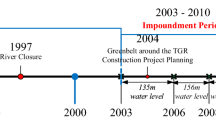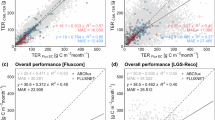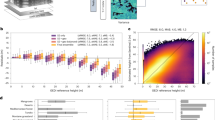Abstract
Nature abounds with beautiful and striking landscapes, but a comprehensive understanding of their forms requires examples where detailed comparisons can be made between theory and experiment. Geothermal hot springs1 produce some of the most rapidly changing terrestrial landscapes, with reported travertine (calcium carbonate) growth rates as high as 5 mm per day2,3,4. Unlike most landscapes, the patterns of which are the result of erosion processes on timescales of millions of years, the hot-spring depositional landscapes exhibit a spectacular cascade of nested ponds and terraces5, for which the origins and quantitative characterization have remained elusive. Here, we take advantage of this millionfold difference in geological timescale to present a novel combination of data from time-lapse photography, computer simulation and mathematical modelling that explains the emergence of the large-scale pond and terrace patterns, predicts and verifies the dynamics of their growth and shows that these patterns are scale invariant.
This is a preview of subscription content, access via your institution
Access options
Subscribe to this journal
Receive 12 print issues and online access
$259.00 per year
only $21.58 per issue
Buy this article
- Purchase on SpringerLink
- Instant access to full article PDF
Prices may be subject to local taxes which are calculated during checkout





Similar content being viewed by others
References
Ford, T. & Pedley, H. A review of tufa and travertine deposits of the world. Earth Sci. Rev. 41, 117–175 (1996).
Friedman, I. Some investigations of the deposition of travertine from hot springs: I. The isotope chemistry of a travertine-depositing spring. Geochim. Cosmochim. Acta 34, 1303–1315 (1970).
Pentecost, A. & Viles, H. A. A review and reassessment of travertine classification. Geogr. Phys. Quaternaire 48, 305–314 (1994).
Fouke, B. W. et al. Depositional facies and aqueous-solid geochemistry of travertine-depositing hot springs (Angel Terrace, Mammoth Hot Springs, Yellowstone National Park, USA). J. Sed. Res. 70, 265–285 (2000).
Allen, E. T. & Day, A. L. Hot springs of the Yellowstone National Park. Tech. Rep. publication 466, Carnegie Institute of Washington (1935).
Murray, A. B. & Paola, C. A cellular model of braided rivers. Nature 371, 54–57 (1994).
Goldenfeld, N., Chan, P. & Veysey, J. Dynamics of precipitation pattern formation at geothermal hot springs. Phys. Rev. Lett. 96, 254501 (2006).
Short, M. B., Baygents, J. C. & Goldstein, R. E. Stalactite growth as a free-boundary problem. Phys. Fluids 17, 083101–083112 (2005).
Short, M. B. et al. Stalactite growth as a free-boundary problem: A geometric law and its platonic ideal. Phys. Rev. Lett. 94, 018501–018504 (2005).
Hammer, Ø., Dysthea, D. & Jamtveit, B. The dynamics of travertine dams. Earth Planet. Sci. Lett. 256, 258–263 (2007).
Jeong, H.-C. & Williams, E. D. Steps on surfaces: Experiment and theory. Surf. Sci. Rep. 34, 171–294 (1999).
Grotzinger, J. P. & Rothman, D. H. An abiotic model for stromatolite morphogenesis. Nature 383, 423–425 (1996).
Joós, B., Einstein, T. L. & Bartelt, N. C. Distribution of terrace widths on a vicinal surface within the one-dimensional free-fermion model. Phys. Rev. B 43, 8153–8162 (1991).
Stone, D. & Goldstein, R. Tubular precipitation and redox gradients on a bubbling template. Proc. Natl Acad. Sci. 101, 11537–11541 (2004).
Efron, B. & Tibshirani, R. An Introduction to the Bootstrap (Chapman & Hall/CRC, New York, 1994).
Press, W. H., Teukolsky, S. A., Vetterling, W. T. & Flannery, B. P. Numerical Recipes in C 2nd edn (Cambridge Univ. Press, New York, 1992).
Acknowledgements
This work was carried out as part of a comprehensive geochemical and microbial ecology study of Yellowstone’s carbonate hot springs. We thank our colleagues B. Fouke, M. Kandianis and T. Schickel for valuable discussions. A special debt is due to ranger B. Suderman of the US Park Service for photography, N. Guttenberg for assistance rendering simulations and P. Y. Chan for discussions and penmanship. This work was funded by the US National Science Foundation.
Author information
Authors and Affiliations
Contributions
J.V. and N.G. contributed equally to all aspects of this research.
Corresponding author
Supplementary information
Supplementary Information
Supplementary Information and Supplementary Figure 1 (PDF 109 kb)
Rights and permissions
About this article
Cite this article
Veysey II, J., Goldenfeld, N. Watching rocks grow. Nature Phys 4, 310–313 (2008). https://doi.org/10.1038/nphys911
Received:
Accepted:
Published:
Issue date:
DOI: https://doi.org/10.1038/nphys911
This article is cited by
-
Travertine crystal growth ripples record the hydraulic history of ancient Rome’s Anio Novus aqueduct
Scientific Reports (2022)
-
Shape evolution of ooids: a geometric model
Scientific Reports (2018)
-
A vehicular theory of corporeal qualia (a gift to computationalists)
Philosophical Studies (2011)
-
Watch your step
Nature Physics (2008)



